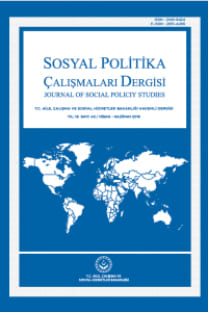Üniversite Son Sınıf Öğrencilerinin Evliliğe Bakış Açısı
Giriş ve Amaç: Çalışma, üniversite gençlerinin evliliğebakış açılarını belirlemek amacıyla yapılmıştır.Gereç ve Yöntem: Tanımlayıcı çalışma, 2006-2007Öğretim yılı Bahar Döneminde Başkent Üniversitesi SağlıkBilimleri Fakültesi son sınıfta okuyan ve partneri olan öğrenciler(n=70) araştırma kapsamına alınmıştır. Öğrencilerin veebeveynlerinin sosyo-demografik özelliklerini, evlilik, boşanmave cinsel yaşama ilişkin özelliklerini belirlemek amacıylaaraştırmacı tarafından geliştirilen anket formu kullanılmıştır.Bulgular: Öğrencilerin % 58.6’sı bayan, %41.4’ü erkek,%80’i 20-22 y, %20’si 23 y ve üzeri, %4.3’ü nişanlı, %88.6’sısözlü, %7.1’i partneri ile birlikte yaşamakta, öğrencileringenelinin gelir durumu ve ebeveyn eğitim düzeyi ortanınüzerindedir. Öğrencilerin çoğu evliliği “sorumluluk alma”(%94.2) ve “hayatı paylaşma” (%98.5) şeklinde tanımlamışlardır.En uygun evlilik yaşının 25-29 yaşları olduğunu, yarıdanfazlası (%57.1) şu anki partneri ile evliliği düşündüğünü,evleneceği kişinin en çok “iyi huylu olması” (%94.2) ve “eğitimliolması” (%97.1) yönünde görüşleri olduğunu, %82.9’ueş seçiminde kendi kararını verdikten sonra ailesinin onayınıalacağını ve %84.3’ü sanal ortamda tanışarak yapılan evlilikleresıcak bakmadıklarını belirtmişlerdir.Sonuç: Çalışmadan elde edilen sonuçlara göre gençlerin,genel olarak evliliğe karşı duyarlı ve özenli yaklaşımgösterdikleri, ancak umutla baktıkları söylenebilir. Gençlerevliklerinde iletişim problemleriyle baş edebileceklerine inanırken,cinsel sorunlar karşısında aynı ölçüde rahat hissetmediklerive evlilik öncesi danışmanlığa ihtiyaç duyduklarınıbelirtmişlerdir.
The Opinions of the University Youth about Marriage
Introduction and Purpose:The purpose of this study isto determine the opinions of the university youth aboutmarriage.Material and Method: It is a descriptive study and thesenior class students who study in Baskent University HealthScience Faculty 2006-2007 Academic Year Spring Semesterand also have partners (n=70) are taken into the research.Questionnaire form that is developed by the researcher isused for determining the students’ and parents’ sociodemographiccharacteristics and their characteristics relatingto the marriage, disengaging and the sexual life.Result: %58.6 of students are female, %41.4 are male,%80 are 20-22 years old, %20 are 23 and older ages, %4.3are engaged, %88.6 are engaged to be married, %7.1 areliving together with their partners and generally their economicconditions and their parents’ education status is higher thanaverage. Most of the students define marriage as “takingresponsibility” (%94.2) and as “sharing the life” (%98.5).They designate that the most appropriate marrying age isbetween 25 and 29, more than half of them (%57.1) statethat they think marriage with their present partner, %94.2have a point of view that the most important thing for themarriage is the partner’s being good-natured and %97.1 tellthat the partners have to be educated, %82.9 denote thatthey will take the decision of their parents after they decideand %84.3 say that they do not endorse the marriages thatare made by meeting on internet.Conclusion: According to the results that are obtainedfrom the research, they generally have sensitive and attentiveapproach to the marriages but they are hopefull aboutmarriages. They beleive that they can handle with thecommunication problems but they think that they can notcompletely cope with the sexual problems and state that theyneed a premarital consultancy.
___
- Günay, O. Aile ve Sağlık, Aile Sağlığı El Kitabı, Ed: Yusuf Öztürk, Osman Günay, Kayseri, s.1-5. 1995.
- Özgüven, İE. Evlilik ve Aile Terapisi, PDREM Yayın- ları, Ankara, s.21. 2000.
- Stahmann RF. Premarital Counselling: A Focus For Family Therapy, The Association For Family The- rapy 2000, Published by Blackwell Publishers, Ox- ford, 22:104-116. 2000.
- Vural, BK., Temel, AB. Bireylerin Evlilik Öncesi Da- nışmanlık Programına Katılım Öngörülerinin İnce- lenmesi. 11. Ulusal Halk Sağlığı Kongresi, 23-26 Ekim. Denizli. s. 34. 2007.
- Purnine, DM., Carey, MP. Interpersonel communi- cation and sexual adjustment the roles of unders- tanding and agreement, Journal of Consulting and Clinical Psychology, 65(6): 1017-1025. 1997.
- Dunn, KM., Croft, PR., Hackett, GI. Satisfaction in the sex life of a general population sample, Journal of Sex and Marital Therapy, 26:141- 151. 2000. 2007.
